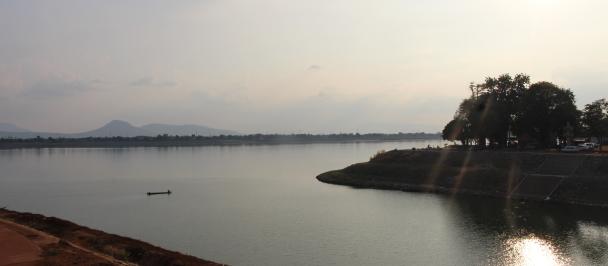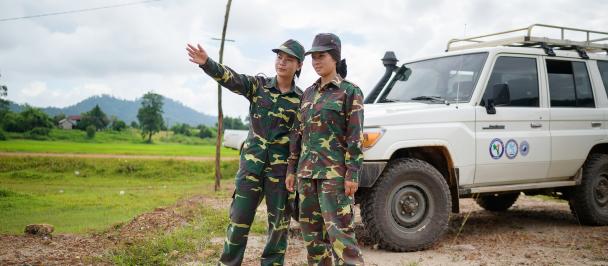Enhancing Integrated Water Management and Climate Resilience in Vulnerable Urban Areas of the Mekong River Basin
Enhancing Integrated Water Management and Climate Resilience in Vulnerable Urban Areas of the Mekong River Basin
Banks of the Xe Don River in the dry season. Photo by: UNDP Lao PDR
Summary:
This project seeks to address the critical need for risk data to inform integrated water resources management and, in so doing, enable increased investment in risk reduction measures in Lao PDR and Cambodia. There is a strong connection between the upstream and downstream impacts associated with floods and water availability in the transboundary region. As such, the project seeks to address these problems faced while acknowledging the transboundary nature of the challenge and making adjustments as necessary to tailor for the variances of each country. Taking a barrier-removal approach, the project will address gaps in data collection, management and analysis, enhance institutional and technical capacity at the subnational level for integrated climate and flood risk management, enhance the availability of resources for investment in water-related risk reduction, and aid the flow of risk knowledge and coordination across borders.
The project will also contribute towards improved hydrological and climate risk modelling and information systems, which will in turn inform flood management as well as adaptation planning, and enhance the capacity of national and provincial decision-makers, as well as local stakeholders through the use of the improved information system.
The project applies a human rights-based approach to address development challenges associated with disasters and enhance resilience to increasing climate risks through improved policy, strengthened capacity, and risk information. This approach fosters resilient and sustainable socio-economic development and contributes to the achievement of the SDGs.
Background:
The Mekong River is a defining landscape feature as 60% of its length runs through Lao PDR. There is seasonal flooding every year in the central and southern parts of the country. Flooding is a major cause of disasters in the country – both in terms of frequency and intensity as well as impacts. In 2018, Lao PDR saw the largest floods it has seen in a decade, with Tropical Storm Son-Tihn on July 18-19, followed by flash flooding on July 23-24 caused by a breach in the Xepien-Xenamnoy saddle hydropower dam. This dam breach affected nearly 7,000 people downstream and displaced more than 1,000. In August of the same year, Tropical Storm Bebinca hit and caused further flooding with widespread damage, destroying livelihoods and disrupting economic activity and social conditions and affecting 17 provinces as well as the capital. The southern provinces of Khammuone, Champasak, and Saravane, with a combined population of over 1 million, were the hardest hit during the 2018 flooding events.
And, from January to August 2019, multiple flooding disasters occurred again across the country affecting 10 provinces. As per available estimates from NDMO on 8 Sept 2019, a total of 396,806 persons were affected by floods with estimated capital exposure of about USD 753.4 million. According to assessments from UNITAR-UNOSAT, within 60,000 sq. km. of southern Lao PDR, about 1,000 sq. km. was flooded – an area home to about 1,606,500 people. Recent climate projections for Lao PDR show increasing temperatures, higher intensity of rainfall and longer dry periods which can give rise to more severe droughts and flooding. Early warning systems and data management are limited, and climate risks are not well integrated into rural and agricultural development policies. Persistence of monoculture, lack of livelihood diversity, low levels of disaster preparedness, and limited infrastructure mean that resilience to the risks posed by this climate change at the community level remains low.
Objectives:
The main objective of the project is to strengthen the climate and disaster resilience of people and communities in vulnerable regions of Lao PDR and Cambodia through improved risk and vulnerability assessment and advancing an integrated approach to water resources management.
- Inclusive assessment of water-related climate risks completed in the priority river basins.
- Enabling environment for gender-responsive climate risk-informed integrated water resources management developed.
- Funding proposal for priority risk reduction measures developed.
Project Output:
The country-level project activities aim to:
- Climate risk and water resources management baseline examined.
- Detailed climate and disaster risk assessments completed for Xe Bang Fai and Xe Don river basins, with a focus on two priority urban areas.
- Institutional and technical capacity for long-term climate resilience and integrated water resource management was assessed for two priority urban areas.
- Identify and prioritize adaptation and DRR actions to build preparedness and reduce long-term water-related climate risks.
- Carry out capacity building to enhance risk-informed, gender-responsive integrated water resources management and strengthen community disaster preparedness and EWS systems
GESI (Gender Equality & Social Inclusion) component
Across the Mekong sub-region, women, the elderly, people with disability or who belong to an ethnic minority – are disproportionately affected by major social and environmental changes, including those associated with the private sector of water. Although, governments in the region and regional organisations have increasingly made legislative and policy commitments to gender equality and integrated gender into their plans and strategies, however, in practice, their vision remains unrealised due to deep-seated social and gender norms that disadvantage women.
This project contributes to gender equality and women’s empowerment in the implementation of all activities and challenges existing structural barriers. The project will develop a gender action plan, stakeholder engagement plan, and regional indigenous peoples' planning framework during the first year. All policy, institutional, legislative, and coordination measures integrate gender equality considerations and advance active participation and engagement of women and their representative entities. Risk management and resilience-building interventions address gendered dimensions of resilience building and facilitate an active decision-making role for women in their communities.
Project details:
- Status: Ongoing
- Start Date: September 2021
- End Date: September 2025
- Project Office: Department of Water Resources, Ministry of Natural Resources and Environment
- Focus Area: Champasack and Khammouane Province
- Collaborating Partners: Department of Water Resources, Ministry of Natural Resources and Environment, Department of Social Welfare, Ministry of Labour and Social Welfare
- Total budget: $1,593,025.92
Download related documents:

 Locations
Locations


